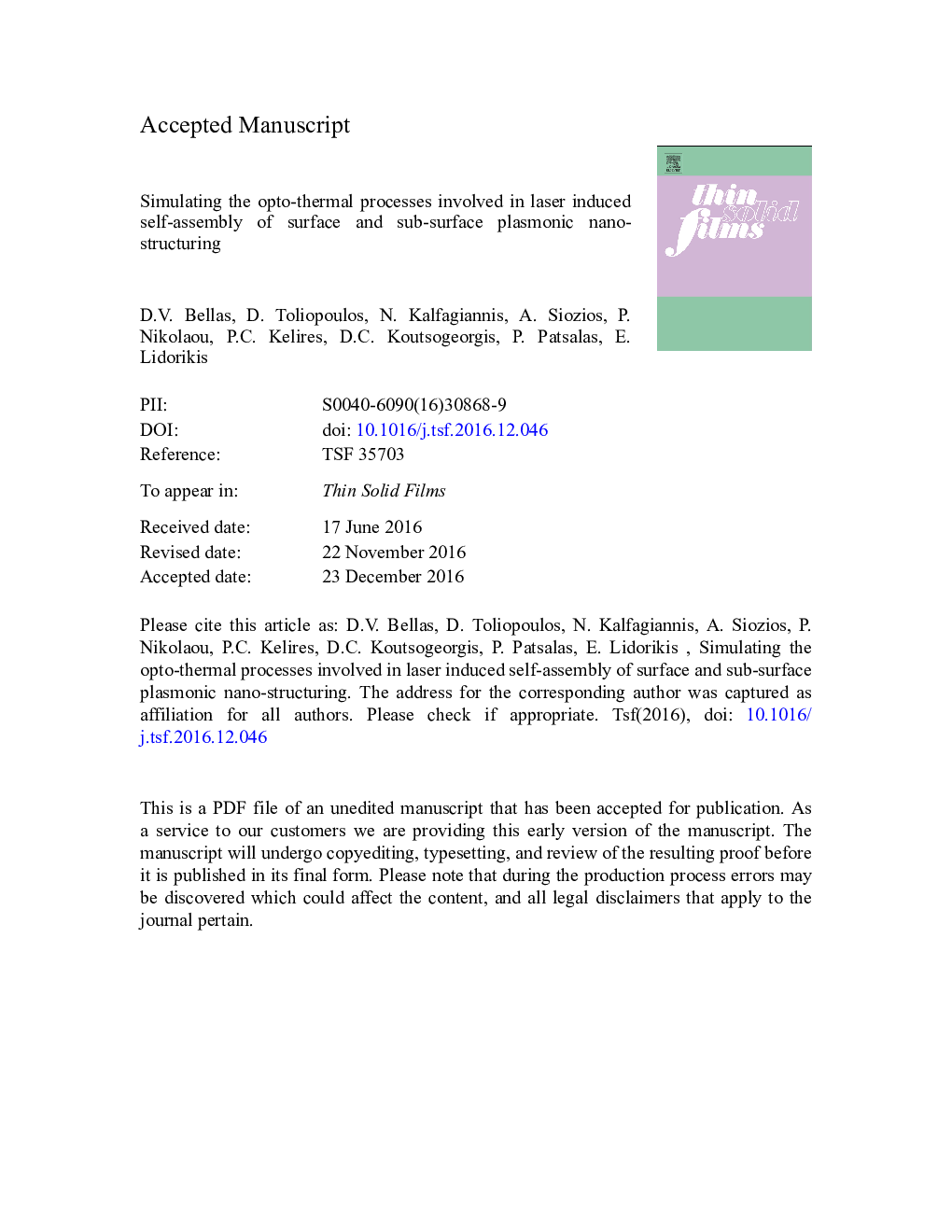| کد مقاله | کد نشریه | سال انتشار | مقاله انگلیسی | نسخه تمام متن |
|---|---|---|---|---|
| 5466155 | 1517982 | 2017 | 40 صفحه PDF | دانلود رایگان |
عنوان انگلیسی مقاله ISI
Simulating the opto-thermal processes involved in laser induced self-assembly of surface and sub-surface plasmonic nano-structuring
ترجمه فارسی عنوان
شبیه سازی فرآیندهای اپتیکی و حرارتی که در خودسازگاری ناشی از لیزر ایجاد شده اند از ساختار نانو ساختار پلاسمونی سطح و زیر سطحی
دانلود مقاله + سفارش ترجمه
دانلود مقاله ISI انگلیسی
رایگان برای ایرانیان
کلمات کلیدی
ترجمه چکیده
ساختار نانو ساختار فلزات یکی از بزرگترین چالش های آینده برای دستگاه های پلاسمونی و فوتونی است. چنین فن آوری نیاز به توسعه فن آوری های فوق العاده سریع، با کارایی بالا و کم هزینه دارد. پردازش لیزری برای ویژگی های فوق ذکر شده است، که نشان دهنده یک ابزار بی نظیر در جهت پیش بینی ورود ماژول های مبتنی بر نانو ساختارهای فلزی است که دارای مزیت دیگری می باشند: سهولت مقیاس پذیری. به طور خاص، نانو ساختار لیزر یک فیلم فلزی فوقالعاده نازک یا یک فیلم فلزی متناوب روی یک فیلم سوبستری / فلزی بر روی یک بستر به ترتیب بر روی سطح (نانوذرات فلزی روی سطح بستر) یا زیر سطح (نانوذرات فلزی جاسازی شده در دی الکتریک ماتریس) الگوهای پلاسمونی با بسیاری از برنامه های کاربردی. در این کار، ما به صورت تئوری به بررسی فرایندهای عکس-حرارتی در ساختار نانو ساختار پلاسمونی سطح و زیر سطحی و مقایسه آن با آزمایش ها می پردازیم. برای این منظور، ما در حال ارائه یک فرآیند طراحی و ساخت نانو ساختارهای پلاسمونی کارآمد با مورفولوژی پیش تعیین شده با تنظیم پارامترهای آنیل مانند فلوئورس لیزر و طول موج و / یا پارامترهای ساختار مانند ضخامت فیلم فلزی و نسبت حجم فیلم فلزی بر روی یک کامپوزیت فلزی بستر. برای ساختار نانو ساختار پلاسمونی سطح، ما توانایی تنظیم طول موج لیزر را به صورت منطبق با طیف جذبی فلز یا با فرکانس نوسان پلاسما تشدید می کنیم، یعنی ما از مکانیزم های مختلف جذب نوری استفاده می کنیم که اندازه گیری های انتخابی هستند. بنابراین، ما بر چالش بزرگی از خود سازگاری با لیزر بوجود می آید با ترکیب کاراکتر به طور همزمان در مقیاس دقت با مقیاس نانومتری. از سوی دیگر، برای ساختار نانو ساختارهای پلاسمونی زیر، از گرادیانهای دما استفاده می کنیم که به صورت فضایی در ساختار نانو کامپوزیت فلز / دی الکتریک در طول درمان لیزر ایجاد می شود. ما دریافتیم که درجه گرادیان توسعه یافته به شدت وابسته به ویژگی نانوکریستال میزبان دی الکتریک است که تعیین کننده هدایت حرارتی آن، ترکیب سرامیک / فلز و ضخامت کل فیلم نانو کامپوزیت است. پارامترهای مواد مذکور با پارامترهای انجماد لیزر همراه با پیش طراحی مورفولوژی نهایی ساختار پلاسمونی زیر سطح می توانند مورد استفاده قرار گیرند. فرایندهای پیشنهادی می تواند به عنوان یک پلتفرمی که پیشرفت بیشتری را نسبت به مهندسی دستگاه های پلاسمونی انجام می دهد، خدمت کند.
موضوعات مرتبط
مهندسی و علوم پایه
مهندسی مواد
فناوری نانو (نانو تکنولوژی)
چکیده انگلیسی
Nano-structuring of metals is one of the greatest challenges for the future of plasmonic and photonic devices. Such a technology calls for the development of ultra-fast, high-throughput and low cost fabrication techniques. Laser processing accounts for the aforementioned properties, representing an unrivalled tool towards the anticipated arrival of modules based in metallic nano-structures, with an extra advantage: the ease of scalability. Specifically, laser nano-structuring of an ultra-thin metal film or an alternating metal film on a substrate/metal film on a substrate results respectively on surface (metallic nanoparticles on the surface of the substrate) or subsurface (metallic nanoparticles embedded in a dielectric matrix) plasmonic patterns with many applications. In this work we investigate theoretically the photo-thermal processes involved in surface and sub-surface plasmonic nano-structuring and compare to experiments. To this end, we present a design process and develop functional plasmonic nano-structures with pre-determined morphology by tuning the annealing parameters like the laser fluence and wavelength and/or the structure parameters like the thickness of the metallic film and the volume ratio of the metal film on a substrate-metal composite. For the surface plasmonic nano-structuring we utilize the ability to tune the laser's wavelength to either match the absorption spectral profile of the metal or to be resonant with the plasma oscillation frequency, i.e. we utilize different optical absorption mechanisms that are size-selective. Thus, we overcome a great challenge of laser induced self assembly by combining simultaneously large-scale character with nanometer scale precision. For subsurface plasmonic nano-structuring, on the other hand, we utilize the temperature gradients that are developed spatially across the metal/dielectric nano-composite structure during the laser treatment. We find that the developed temperature gradients are strongly depended on the nanocrystalline character of the dielectric host which determines its thermal conductivity, the composition of the ceramic/metal and the total thickness of the nano-composite film. The aforementioned material parameters combined with the laser annealing parameters can be used to pre-design the final morphology of the sub-surface plasmonic structure. The proposed processes can serve as a platform that will stimulate further progress towards the engineering of plasmonic devices.
ناشر
Database: Elsevier - ScienceDirect (ساینس دایرکت)
Journal: Thin Solid Films - Volume 630, 30 May 2017, Pages 7-24
Journal: Thin Solid Films - Volume 630, 30 May 2017, Pages 7-24
نویسندگان
D.V. Bellas, D. Toliopoulos, N. Kalfagiannis, A. Siozios, P. Nikolaou, P.C. Kelires, D.C. Koutsogeorgis, P. Patsalas, E. Lidorikis,
